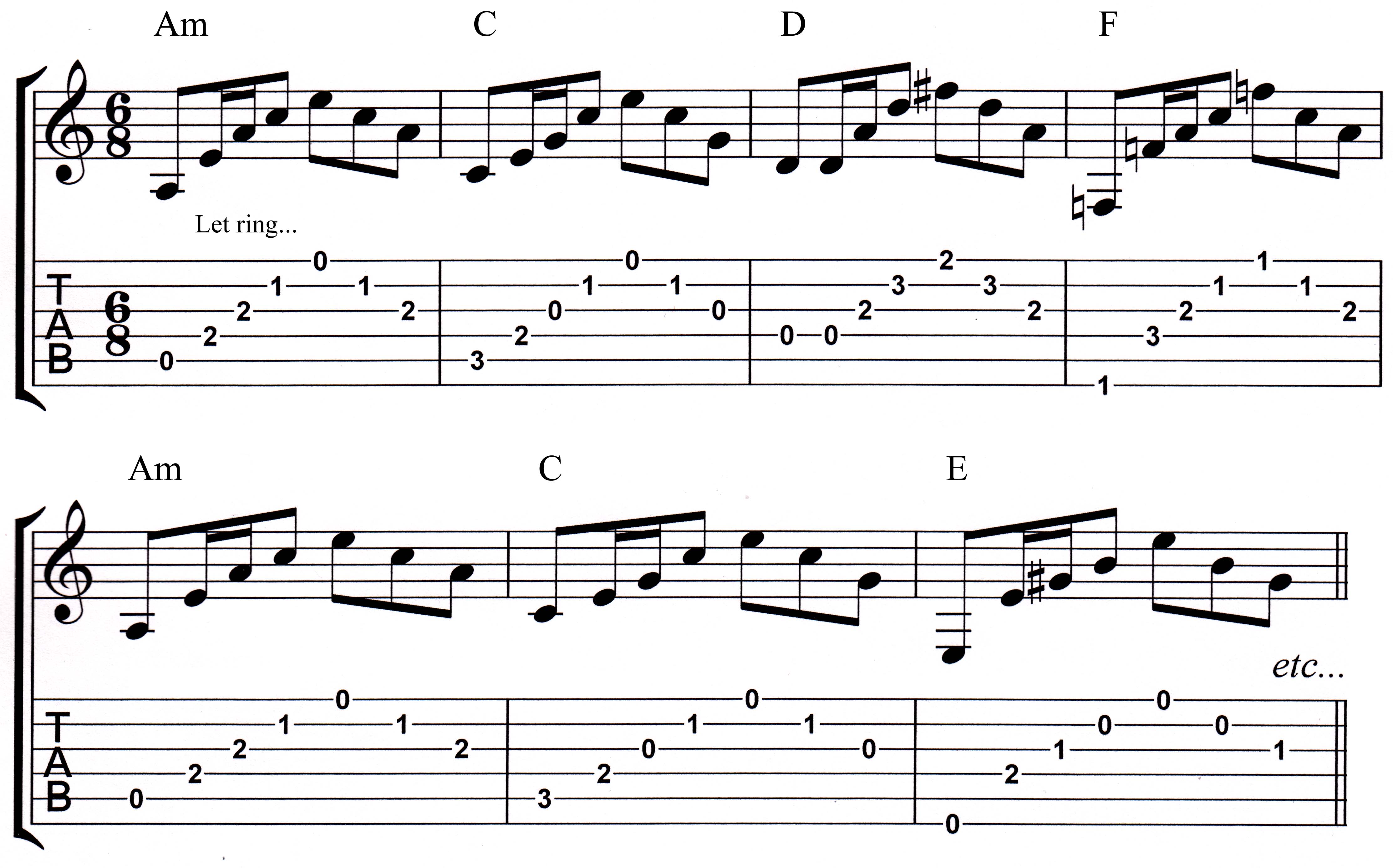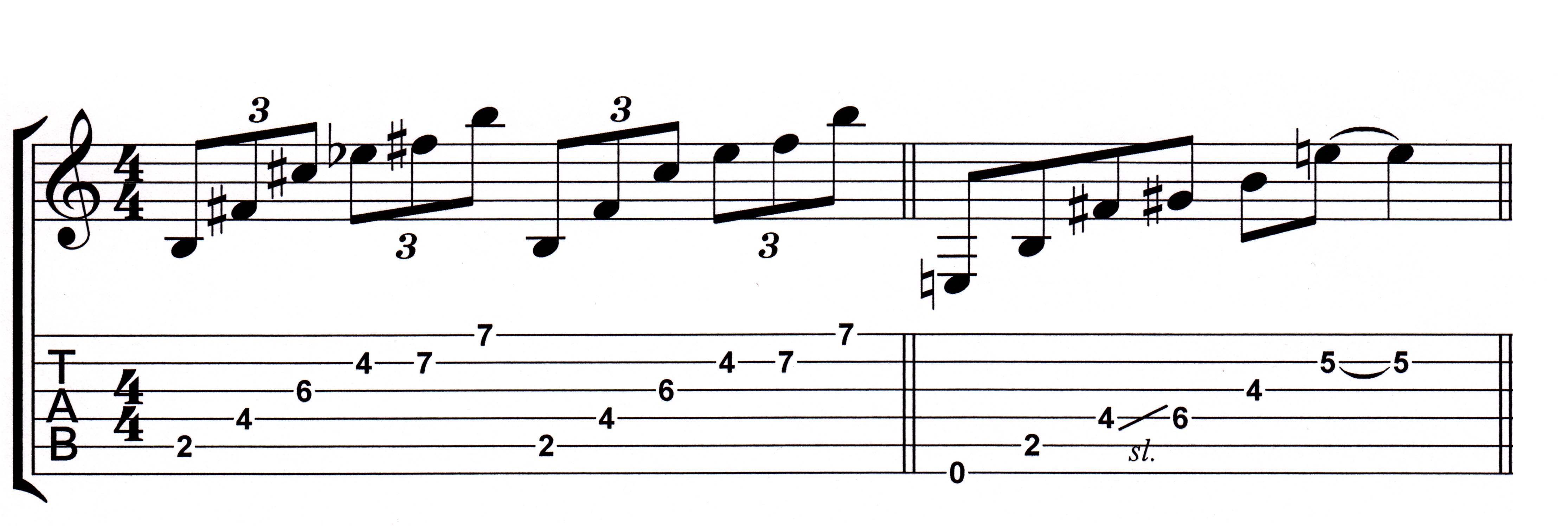
Arpeggios. The word strikes terror into the hearts and fingers of many guitar players. Aren't they really hard? The answer depends upon your perspective.
No, really. I'm not dodging the question. If you believe a thing is hard, it will be because you have predetermined that it already is hard.
I prefer the word "challenging" for a number of reasons. Let me explain...
While arpeggios are among the least understood concepts in the lexicon of most guitar players' knowledge base, and among the last things a player will tackle - due in
part to misperceptions of what they are, how they work, and how difficulty they are thought to be to learn - it is important to demystify this topic and demonstrate
that you may already be playing arpeggios in some form or another.
It is almost a requisite function of metal players to demonstrate Herculean sweep picking technique at blinding speed in their music. It isn't very musical, but it is
very impressive to hear. So if you like metal, you are most likely already hearing arpeggios, and may be trying to figure out what they are. Well, read on.
Jazz players have been using the arpeggio for forever; horn players use them all the time. Listen to Mozart, Beethoven and other Classical composers - arpeggios are
literally everywhere in their music.
People like Eric Johnson demonstrate how the form can be applied in melodic ways in some pretty heavy progressive rock tunes. Just listen to "Venus Isle" for a fully
realized application of the technique we hear begun on "Ah Via Musicom". Joe Satriani and Steve Vai, too, are masters of the form. And for students of these players,
it is a very necessary discipline if you want to emulate their approach to music.
So, what are arpeggios, in case you don't actually know? The simplest way to explain it is that arpeggios are chords, but played one note at a time. Sometimes you
let the notes ring out as the chord unfolds with each note played, as in the first two examples below.
First, the signature rhythm part taken from Greg Kihn's 1980s hit, "The Breakup Song". The "T" below the F chord means to use your thumb (club grip) to play
the low F tone of the chord.

Notice the chords you are actually playing? An Am, F and G chord; that's it. To insure accuracy and smooth sequencing of notes, use a metronome to regulate your tempo. Arpeggios want to be played smoothly, without jarring and irregular rhythmic flow. This is very important so don't skirt around this aspect of learning to play these beasties. If you're going to tackle them, do it right. Use a metronome! Start slow and work up to speed only as you can execute them well. Preserve technique as you increase tempo or it will fall apart!
Next is the famous arpeggiated rhythm used in the Animals' cover of "House Of The Rising Sun", using Am, C, D, F, and E.

As you can see by these two examples, this can be very powerful stuff. Again, use your metronome to pace yourself and properly execute each exercise.
The next rhythm is one created by Andy Summers in what is probably the Police's biggest hit ever, "Every Breath You Take". The chords used are Amaj9,
F♯mi9, Dsus2, and Esus2.

This is powerful stuff. Andy palm mutes the notes just enough for clarity, and the relentless use of eighth notes drives the song forward. His use of Maj9 and mi9 chords, along with the sus2 chords creates a very unique quality that would not have worked if they had been just major and minor chords and then also just strummed behind the vocal melody.
When you understand that strumming chords does not always make for the best approach, arpeggios are one technique you can try in finding the best expression of the rhythm part you've written. Each of the three rhythm examples above demonstrate three basic approaches, in order of increased complexity; if not in how much is played, then in the vocalization of the chords.
Okay, so let's get on some soloing ideas.
Remember, when using arpeggios in a solo, you are still playing chords, so they have to be relevant to the rhythm over which you are playing! This is important to remember because if you go too far off, there will be dissonant clashes harmonically that might be very disruptive to the melodic integrity of what you are striving to say through the solo melody.
That said, the first example is a basic positional form of a minor 7 arpeggio in A

Once you have it figured out, bring in the metronome to pace yourself.
Next is the same arpeggio, but done vertically up the fret board, covering three octaves.

In the next example, we play "behind" the starting point - a very important element of playing any scale or arpeggio, to remember it isn't just vertical. There are
notes "behind" the position you're playing at on the fret board. You should strive to find alternative ways to play almost everything. This arpeggio is also in
Am7.

Now, let's move to a couple different ideas. The next two are simple arpeggios. The first is a Bmaj9 and the second is an E major arpeggio. Let the
notes ring out as they will on the E major arpeggio, especially the low E tone. It creates a kind of pedal point continuity for the run.

Okay, one more for you. This one is a basic ascending chord sequence you've heard a million times, but taking this typical ♭VI, ♭VII,
i idea, and making it into an arpeggiated "run". It's both rhythmic and melodic at the same time. You'll be playing a C, D, and Em,
in that order.

As you may now be starting to see, the value of arpeggios cannot be understated, or underestimated. They add an important technical and expressive dimension to your playing skill, and can even give people the impression you are better than you may actually be - especially if you take these ideas and experiment with them to find something relatively easy to play, and when played well, will sound killer when dropped into your rhythmic or melodic playing at the right time!
We'll cover more on this topic in other areas of the site at a later date.
Okay, now shut off your computer and go play with some ideas.
See you next time.